Input interpretation

H_2O water + FeCl_3 iron(III) chloride + Na_2SO_3 sodium sulfite ⟶ HCl hydrogen chloride + Na_2SO_4 sodium sulfate + FeCl_2 iron(II) chloride
Balanced equation
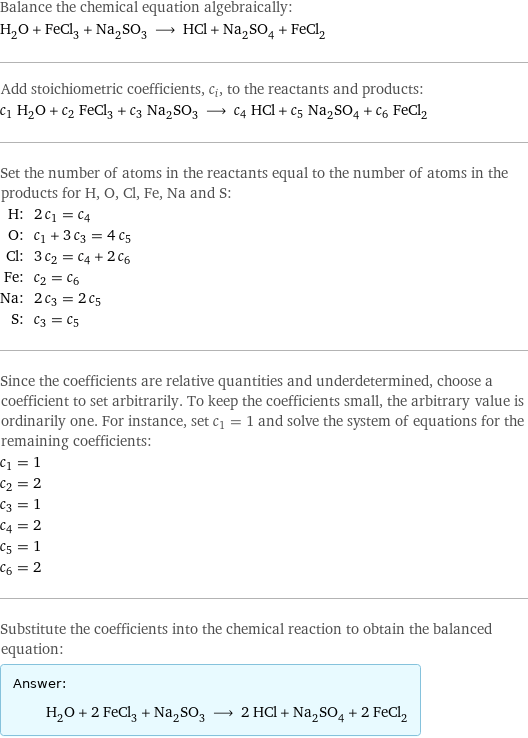
Balance the chemical equation algebraically: H_2O + FeCl_3 + Na_2SO_3 ⟶ HCl + Na_2SO_4 + FeCl_2 Add stoichiometric coefficients, c_i, to the reactants and products: c_1 H_2O + c_2 FeCl_3 + c_3 Na_2SO_3 ⟶ c_4 HCl + c_5 Na_2SO_4 + c_6 FeCl_2 Set the number of atoms in the reactants equal to the number of atoms in the products for H, O, Cl, Fe, Na and S: H: | 2 c_1 = c_4 O: | c_1 + 3 c_3 = 4 c_5 Cl: | 3 c_2 = c_4 + 2 c_6 Fe: | c_2 = c_6 Na: | 2 c_3 = 2 c_5 S: | c_3 = c_5 Since the coefficients are relative quantities and underdetermined, choose a coefficient to set arbitrarily. To keep the coefficients small, the arbitrary value is ordinarily one. For instance, set c_1 = 1 and solve the system of equations for the remaining coefficients: c_1 = 1 c_2 = 2 c_3 = 1 c_4 = 2 c_5 = 1 c_6 = 2 Substitute the coefficients into the chemical reaction to obtain the balanced equation: Answer: | | H_2O + 2 FeCl_3 + Na_2SO_3 ⟶ 2 HCl + Na_2SO_4 + 2 FeCl_2
Structures
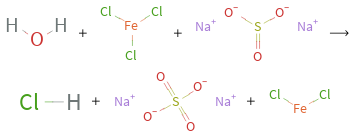
+ + ⟶ + +
Names

water + iron(III) chloride + sodium sulfite ⟶ hydrogen chloride + sodium sulfate + iron(II) chloride
Reaction thermodynamics
Enthalpy
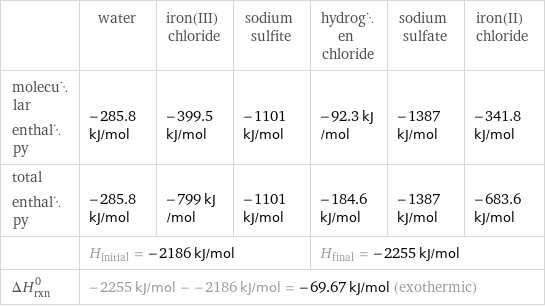
| water | iron(III) chloride | sodium sulfite | hydrogen chloride | sodium sulfate | iron(II) chloride molecular enthalpy | -285.8 kJ/mol | -399.5 kJ/mol | -1101 kJ/mol | -92.3 kJ/mol | -1387 kJ/mol | -341.8 kJ/mol total enthalpy | -285.8 kJ/mol | -799 kJ/mol | -1101 kJ/mol | -184.6 kJ/mol | -1387 kJ/mol | -683.6 kJ/mol | H_initial = -2186 kJ/mol | | | H_final = -2255 kJ/mol | | ΔH_rxn^0 | -2255 kJ/mol - -2186 kJ/mol = -69.67 kJ/mol (exothermic) | | | | |
Gibbs free energy
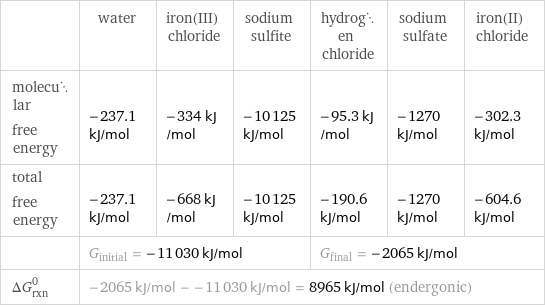
| water | iron(III) chloride | sodium sulfite | hydrogen chloride | sodium sulfate | iron(II) chloride molecular free energy | -237.1 kJ/mol | -334 kJ/mol | -10125 kJ/mol | -95.3 kJ/mol | -1270 kJ/mol | -302.3 kJ/mol total free energy | -237.1 kJ/mol | -668 kJ/mol | -10125 kJ/mol | -190.6 kJ/mol | -1270 kJ/mol | -604.6 kJ/mol | G_initial = -11030 kJ/mol | | | G_final = -2065 kJ/mol | | ΔG_rxn^0 | -2065 kJ/mol - -11030 kJ/mol = 8965 kJ/mol (endergonic) | | | | |
Equilibrium constant
![Construct the equilibrium constant, K, expression for: H_2O + FeCl_3 + Na_2SO_3 ⟶ HCl + Na_2SO_4 + FeCl_2 Plan: • Balance the chemical equation. • Determine the stoichiometric numbers. • Assemble the activity expression for each chemical species. • Use the activity expressions to build the equilibrium constant expression. Write the balanced chemical equation: H_2O + 2 FeCl_3 + Na_2SO_3 ⟶ 2 HCl + Na_2SO_4 + 2 FeCl_2 Assign stoichiometric numbers, ν_i, using the stoichiometric coefficients, c_i, from the balanced chemical equation in the following manner: ν_i = -c_i for reactants and ν_i = c_i for products: chemical species | c_i | ν_i H_2O | 1 | -1 FeCl_3 | 2 | -2 Na_2SO_3 | 1 | -1 HCl | 2 | 2 Na_2SO_4 | 1 | 1 FeCl_2 | 2 | 2 Assemble the activity expressions accounting for the state of matter and ν_i: chemical species | c_i | ν_i | activity expression H_2O | 1 | -1 | ([H2O])^(-1) FeCl_3 | 2 | -2 | ([FeCl3])^(-2) Na_2SO_3 | 1 | -1 | ([Na2SO3])^(-1) HCl | 2 | 2 | ([HCl])^2 Na_2SO_4 | 1 | 1 | [Na2SO4] FeCl_2 | 2 | 2 | ([FeCl2])^2 The equilibrium constant symbol in the concentration basis is: K_c Mulitply the activity expressions to arrive at the K_c expression: Answer: | | K_c = ([H2O])^(-1) ([FeCl3])^(-2) ([Na2SO3])^(-1) ([HCl])^2 [Na2SO4] ([FeCl2])^2 = (([HCl])^2 [Na2SO4] ([FeCl2])^2)/([H2O] ([FeCl3])^2 [Na2SO3])](../image_source/1d417d50a31af6b5c2d2078af097786a.png)
Construct the equilibrium constant, K, expression for: H_2O + FeCl_3 + Na_2SO_3 ⟶ HCl + Na_2SO_4 + FeCl_2 Plan: • Balance the chemical equation. • Determine the stoichiometric numbers. • Assemble the activity expression for each chemical species. • Use the activity expressions to build the equilibrium constant expression. Write the balanced chemical equation: H_2O + 2 FeCl_3 + Na_2SO_3 ⟶ 2 HCl + Na_2SO_4 + 2 FeCl_2 Assign stoichiometric numbers, ν_i, using the stoichiometric coefficients, c_i, from the balanced chemical equation in the following manner: ν_i = -c_i for reactants and ν_i = c_i for products: chemical species | c_i | ν_i H_2O | 1 | -1 FeCl_3 | 2 | -2 Na_2SO_3 | 1 | -1 HCl | 2 | 2 Na_2SO_4 | 1 | 1 FeCl_2 | 2 | 2 Assemble the activity expressions accounting for the state of matter and ν_i: chemical species | c_i | ν_i | activity expression H_2O | 1 | -1 | ([H2O])^(-1) FeCl_3 | 2 | -2 | ([FeCl3])^(-2) Na_2SO_3 | 1 | -1 | ([Na2SO3])^(-1) HCl | 2 | 2 | ([HCl])^2 Na_2SO_4 | 1 | 1 | [Na2SO4] FeCl_2 | 2 | 2 | ([FeCl2])^2 The equilibrium constant symbol in the concentration basis is: K_c Mulitply the activity expressions to arrive at the K_c expression: Answer: | | K_c = ([H2O])^(-1) ([FeCl3])^(-2) ([Na2SO3])^(-1) ([HCl])^2 [Na2SO4] ([FeCl2])^2 = (([HCl])^2 [Na2SO4] ([FeCl2])^2)/([H2O] ([FeCl3])^2 [Na2SO3])
Rate of reaction
![Construct the rate of reaction expression for: H_2O + FeCl_3 + Na_2SO_3 ⟶ HCl + Na_2SO_4 + FeCl_2 Plan: • Balance the chemical equation. • Determine the stoichiometric numbers. • Assemble the rate term for each chemical species. • Write the rate of reaction expression. Write the balanced chemical equation: H_2O + 2 FeCl_3 + Na_2SO_3 ⟶ 2 HCl + Na_2SO_4 + 2 FeCl_2 Assign stoichiometric numbers, ν_i, using the stoichiometric coefficients, c_i, from the balanced chemical equation in the following manner: ν_i = -c_i for reactants and ν_i = c_i for products: chemical species | c_i | ν_i H_2O | 1 | -1 FeCl_3 | 2 | -2 Na_2SO_3 | 1 | -1 HCl | 2 | 2 Na_2SO_4 | 1 | 1 FeCl_2 | 2 | 2 The rate term for each chemical species, B_i, is 1/ν_i(Δ[B_i])/(Δt) where [B_i] is the amount concentration and t is time: chemical species | c_i | ν_i | rate term H_2O | 1 | -1 | -(Δ[H2O])/(Δt) FeCl_3 | 2 | -2 | -1/2 (Δ[FeCl3])/(Δt) Na_2SO_3 | 1 | -1 | -(Δ[Na2SO3])/(Δt) HCl | 2 | 2 | 1/2 (Δ[HCl])/(Δt) Na_2SO_4 | 1 | 1 | (Δ[Na2SO4])/(Δt) FeCl_2 | 2 | 2 | 1/2 (Δ[FeCl2])/(Δt) (for infinitesimal rate of change, replace Δ with d) Set the rate terms equal to each other to arrive at the rate expression: Answer: | | rate = -(Δ[H2O])/(Δt) = -1/2 (Δ[FeCl3])/(Δt) = -(Δ[Na2SO3])/(Δt) = 1/2 (Δ[HCl])/(Δt) = (Δ[Na2SO4])/(Δt) = 1/2 (Δ[FeCl2])/(Δt) (assuming constant volume and no accumulation of intermediates or side products)](../image_source/34a0e523d243d5383fe987f343cd76e0.png)
Construct the rate of reaction expression for: H_2O + FeCl_3 + Na_2SO_3 ⟶ HCl + Na_2SO_4 + FeCl_2 Plan: • Balance the chemical equation. • Determine the stoichiometric numbers. • Assemble the rate term for each chemical species. • Write the rate of reaction expression. Write the balanced chemical equation: H_2O + 2 FeCl_3 + Na_2SO_3 ⟶ 2 HCl + Na_2SO_4 + 2 FeCl_2 Assign stoichiometric numbers, ν_i, using the stoichiometric coefficients, c_i, from the balanced chemical equation in the following manner: ν_i = -c_i for reactants and ν_i = c_i for products: chemical species | c_i | ν_i H_2O | 1 | -1 FeCl_3 | 2 | -2 Na_2SO_3 | 1 | -1 HCl | 2 | 2 Na_2SO_4 | 1 | 1 FeCl_2 | 2 | 2 The rate term for each chemical species, B_i, is 1/ν_i(Δ[B_i])/(Δt) where [B_i] is the amount concentration and t is time: chemical species | c_i | ν_i | rate term H_2O | 1 | -1 | -(Δ[H2O])/(Δt) FeCl_3 | 2 | -2 | -1/2 (Δ[FeCl3])/(Δt) Na_2SO_3 | 1 | -1 | -(Δ[Na2SO3])/(Δt) HCl | 2 | 2 | 1/2 (Δ[HCl])/(Δt) Na_2SO_4 | 1 | 1 | (Δ[Na2SO4])/(Δt) FeCl_2 | 2 | 2 | 1/2 (Δ[FeCl2])/(Δt) (for infinitesimal rate of change, replace Δ with d) Set the rate terms equal to each other to arrive at the rate expression: Answer: | | rate = -(Δ[H2O])/(Δt) = -1/2 (Δ[FeCl3])/(Δt) = -(Δ[Na2SO3])/(Δt) = 1/2 (Δ[HCl])/(Δt) = (Δ[Na2SO4])/(Δt) = 1/2 (Δ[FeCl2])/(Δt) (assuming constant volume and no accumulation of intermediates or side products)
Chemical names and formulas
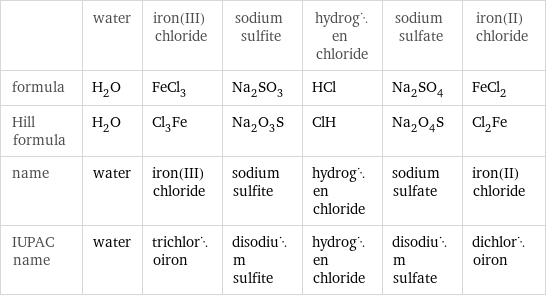
| water | iron(III) chloride | sodium sulfite | hydrogen chloride | sodium sulfate | iron(II) chloride formula | H_2O | FeCl_3 | Na_2SO_3 | HCl | Na_2SO_4 | FeCl_2 Hill formula | H_2O | Cl_3Fe | Na_2O_3S | ClH | Na_2O_4S | Cl_2Fe name | water | iron(III) chloride | sodium sulfite | hydrogen chloride | sodium sulfate | iron(II) chloride IUPAC name | water | trichloroiron | disodium sulfite | hydrogen chloride | disodium sulfate | dichloroiron